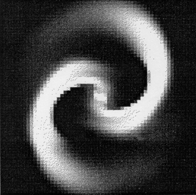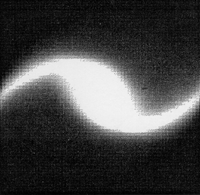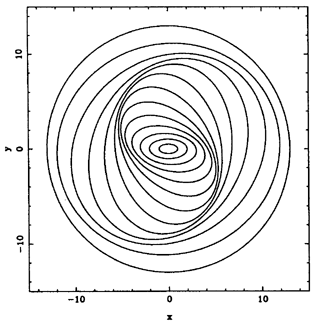
| 
|



12. GAS FLOW IN BARRED GALAXIES
Numerous authors have investigated the behavior of gas in hydrodynamical models, since the early 1970's. Unfortunately, the results appear to depend on the details of the modelling, either as a continuous fluid, dominated by pressure forces, or as ballistic particles, experiencing a few dissipative collisions per orbit. Early simulations have nicely modelled the spiral structures and the associated shocks, but have overlooked ring formation.
12.1. Hydrodynamic Modeling
The most straigthforward way to represent the interstellar medium (ISM) is as a continuous diffuse fluid, essentially governed by pressure forces. This simple model is based on the large-scale atomic gas observations (HI line at 21cm), although this quite diffuse phase appears to be composed of individual clouds at small-scale (see Burton 1992 for a review). In fact, the ubiquity of the HI component is the source of heavy blending and saturation that makes the HI emission appear pervasive and continuous, washing out the discrete, cold and dense hydrogen clouds. Another view of the ISM is gained from molecular cloud studies, essentially from the CO line at 2.6mm, tracing the H2 molecule that has no radio rotational line for symmetry reasons. Molecular clouds are highly clumpy, and show that most of the mass of the ISM has a very low volume filling factor. Current views of the ISM are therefore based on self-similar structures, a hierarchy of clouds over several orders of magnitude in scale (Falgarone et al. 1992; Pfenniger & Combes 1994). These clouds are supported by gravity, and pressure forces could then concern only the smallest scale, much below the parsec size. There coexist several phases in the ISM, with different densities and temperatures, from the cold molecular component (10K), the warm neutral and ionized phases (8000K), to the hot coronal gas (106 K) as emphasized by McKee & Ostriker (1977). However, most of the mass appears to be by far in the cold phase, and a view based on slightly dissipative ballistic clouds emerges. Energy is poured into this medium from the nuclear energy released in stars: supernovae explosions, stellar winds, bipolar flows, etc.
The continuous gas picture has also been favored by the observation of conspicuous dust lanes along spiral arms and bars. These very narrow features, where gas and dust appear to be compressed and the density enhanced, are highly suggestive of shocks. These large-scale shocks, however, do not concern most of the mass in the ISM. The hot phase, the coronal gas, is much too hot to be affected by shocks. The ensemble of molecular clouds could behave as a fluid, with clouds acting as ``molecules'' (Cowie 1980), but the collisional time-scale is larger than the crossing time of spiral arms, and the ensemble does not really act as a fluid (Casoli & Combes 1982). Only the warm and diffuse phase will be trapped in a shock, and its high compression will result in conspicuous thin dust lanes along the leading edges of the bar and spirals (e.g. Elmegreen 1989).

| 
|
The first attempts to simulate gas in barred galaxies were done with the continuous fluid model (e.g. Sanders & Huntley 1976, with the beam scheme). The simulations treated gas as test particles moving in a fixed bar potential. The gas revealed a beautiful spiral structure driven by the bar (see Figure 69). This behavior can be interpreted with the help of the periodic orbit families in a bar potential. We know that the main stable orbits are either aligned parallel or perpendicular to the bar, and that they change orientations by 90° at each resonance. The gas will first tend to follow these orbits, but the streamlines of gas cannot cross. Since periodic orbits do cross, gas clouds can encounter enhanced collisions, such that their orbits are changed. Instead of experiencing sudden 90° turns, their orbits will smoothly and gradually turn, following the schematic diagram of Figure 70: regularly tilted elongated orbits are a vivid illustration of density waves (Kalnajs 1973).

|
This interpretation predicts that the arms will be more wound when there exist more resonances; there will be a winding over 180° with only CR and OLR, with the gas aligned with the bar until corotation. When there exist 2 ILR's, the gas response can be perpendicular to the stellar bar. When there is barely one ILR, strong shocks can occur on the leading edge of the bar, corresponding to the offset dust lanes observed in barred galaxies (Sanders & Tubbs 1980; Schempp 1982). Other continuous gas models have been widely used, with and without gas self-gravity; for example, SPH, finite difference codes, and flux-splitting second order schemes (van Albada 1985; Athanassoula 1992; Wada & Habe 1992; Friedli & Benz 1993; Heller & Shlosman 1994; Teuben 1996). Although these hydrodynamical codes simulate successfully the spiral structure, they are affected by a high viscosity, in large part of numerical origin. In particular, an artificial viscosity is added in order to treat shock waves, and to spread the shock over a few resolution cells. Gas is driven to the central parts very quickly, in spiraling streamlines, and the long time-scale gas behavior cannot be reproduced. This long time-scale is required to form outer ring structures.
The other technique used in galaxy hydrodynamics modeling is the ``sticky particle'' approach, which involves an ensemble of gas clouds moving in ballistic orbits. The individual clouds are free to collide, without extra pressure and viscosity terms (Schwarz 1981, 1984a, b; Roberts & Hausman 1984; Combes & Gerin 1985; Palous et al. 1993; Byrd et al. 1994). In these models, dissipation does not dominate the dynamics, and the long-term behavior can be followed more realistically. There are no large-scale shocks, however. We note that the SPH technique, which considers individual particles with a finite size, is somewhat intermediate between the two approaches: it will approach the fluid behavior only asymptotically for large particle numbers.